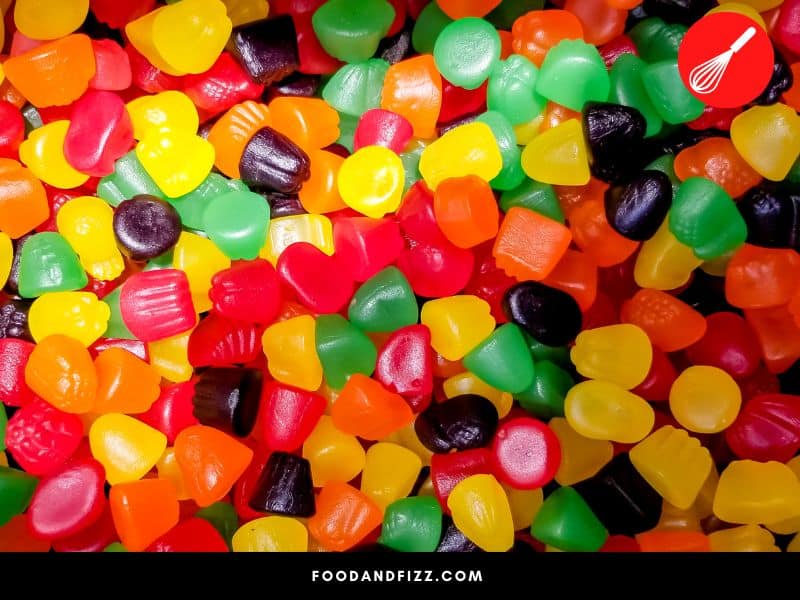Food has the ability to transport us back to specific periods in our life. Flavors, tastes, and textures can trigger the associations in our brains that can lead us to access certain memories.
Candies from our childhood are a perfect example of this. Encountering candy that you used to enjoy when you were a kid can instantly take you back to your younger days, and allow your brain to relive some of those pleasant memories again.
Juju beans are an example of such a candy for most people.
What Are Juju Beans?
Juju beans are a small, firm, chewy type of candy drop that was introduced to the U.S in the 1920s. An early variant of this type of candy included the juice of a jujube fruit as part of its ingredients, which is likely where the Jujube candy got its name. Juju beans come in a variety of colors and flavors and remain a popular snack to this day.

The Origins of The Juju Bean
Juju beans, or Jujubes, are a sweet candy or confectionery that was introduced to the U.S. in the 1920s, although they are said to have been around much earlier in Europe.
As early as the 1700s, recipes for “pate de jujubes” were already around. Pate de jujubes or jujube paste, consisted of the following ingredients: sugar, gum arabic, and the jujube fruit.
By the 1850s, candy makers were already selling juju paste and juju drops, likely as a sweet treat and medicinal lozenge rolled into one.

This is because the Jujube fruit, a date-like berry that was first domesticated in China some 4,000 years ago, is thought to be a demulcent – something that soothes inflammation and injury in mucous membranes, making them helpful for things like sore throat, colds and coughing.
This probably explains why Jujubes the candy became popular as a movie theater snack.
As Charles Perry, a food historian, revealed in an LA Times article many years ago:
“At the turn of the century, jujubes were thought good for chest complaints. Those candies originally contained jujube juice, and they may have been popular in theaters because people didn’t want to cough and disturb their neighbors. Now they’re just chewy, gum-based candies with any sort of fruit flavor.”
From here, we can see that while original jujubes paste candies were sold as a delightful snack, they also likely served a medicinal purpose.
The Jujubes Candy As We Know It
In 1920, A German immigrant by the name of Henry Heide produced the first Jujubes and Jujyfruits as we know it today. It was likely a variation of the juju drops and juju paste that was common during that time. It’s unclear whether his original version included anything of the jujube fruit, but regardless, the Jujube name stuck around.
The Jujubes candy that we know today for sure has nothing to do with the fruit anymore, however, it remains ever popular as a moviehouse snack to this day, much like its original version.
Henry Heide’s company produced Jujubes and Jujyfruits for several decades and it remained a family business until 1995, when the company was sold by his grandson Philip Heide to Hershey’s.
The company was sold again in 2002 to a company that would eventually become the Ferrara Candy Company, which owns Jujubes and Jujyfruits to this day.
The Flavors of Jujubes Candy
When Jujubes first came out, the original flavor line-up included violet, rose, lilac, lemon, and spearmint. Over the years, due to the availability and popularity of flavors, these were swapped out with other flavors.
For a time, the collection of flavors that came in one box included cherry, lemon, lime, orange, and a licorice flavor, but these flavors were eventually swapped out as well.
Currently, the flavors in one Jujube box include wild cherry, lemon, lime, violet, and lilac.
Are Juju Beans the Same as Jujubes?
Juju beans are also known as Jujubes, which are bright and colorful chewy candy drops that come in various fruity flavors. They are completely different though from the Jujube fruit.
What is the Jujube Fruit?
The jujube fruit is a small, red, date-like fruit that is native to China that has been used in traditional medicine for thousands of years. It is also known as the Chinese date or red date.
They have an edible skin with an inedible seed which must be removed. They are greenish when raw but turn red and sweeten in taste as they mature. They taste like a combination of apples and dates, and they taste their best when they have become fully ripe and wrinkly.
Jujubes can be eaten on their own as a snack, made into jams or candies, used in sweet desserts like bread and cakes, made into syrups, added to dishes or stews and soups, and can also be brewed into tea.

Health Benefits of Jujube Fruits
The jujube fruit has tons of health benefits, including:
- High antioxidants
- Helps with sleep
- Improves digestion
- Boosts Immunity
- Anti-inflammatory
- Has anti-bacterial and anti-fungal properties
What is the Connection Between Jujubes the Candy and Jujubes the Fruit?
There is no connection between the Jujubes candy as we know it today and the Jujubes fruit, although early versions of the jujube candy in the 1850s, called juju drops and juju paste, used the jujubes fruit as an ingredient.
When Jujubes candy was introduced in the 1920s, it was likely a variation of these juju drops. Even if it did not have the jujube fruit as an ingredient, the name was used and retained.

What Do Juju Beans Look Like and Taste Like?
Jujubes candy look like small colorful beads that are somewhat waxy and squishy in texture. They are similar to gummy snacks except they are denser and firmer in texture, and can be somewhat harder to chew. They are similar to pastilles, except with fruity and floral flavors.
What Are Juju Beans Made Of?
Juju beans are made of sugar, corn syrup, potato starch, carnauba wax, and natural and artificial flavors and colorings.
What Is The Nutrition Profile of Juju Beans?
There are 130 calories in a 40g serving of Juju Beans Candy. Of this, 34 g are carbohydrates which make up 12% of the daily value recommendation. It contains no fat and no protein.
While delicious and nostalgic, snacks like candy should only be consumed in moderation, as part of a healthy, active lifestyle as they are lacking in nutritional components that we need in order to maintain a healthy body.

Frequently Asked Questions to What Are Juju Beans?
What is The Difference Between Jujyfruits and Jujubes?
In terms of ingredients, Jujyfruits are the same as Jujubes except that Jujyfruits have corn starch as an ingredient instead of potato starch. Jujubes are also firmer than Jujyfruits.
When was Jujebes Candy First Made?
Jujebes was first introduced to the U.S. in 1920, but prior to that, it was already a popular confection in Europe.
Who Made The Original Jujubes?
It was a German immigrant named Henry Heide who first made the Jujubes candy available in the U.S.
Conclusion to What Are Juju Beans?
Juju beans or Jujubes are a type of firm but chewy candy that has been around since the 1920s. They have been a favorite snack of kids for generations.
The modern-day Jujube candy has nothing to do with the Jujube fruit, but its earliest versions included it as an ingredient. It likely became popular due to the fruit’s ability to help with chest pains and cough.
Jujubes candies today are as well-loved as they were when they were first introduced to the country decades ago.

